Reliable VoIP Phone Systems and Service
Configure the Best, Most Reliable VoIP Phone System and ServiceAll of us have experienced poor call quality. Why is VoIP (Voice Over IP) not always reliable? In this presentation, Bruce Gibbs, president of ServiceMark Telecom diagrams how to configure the best, most reliable VoIP phone system and service.
Hi, I’m Bruce Gibbs, president of ServiceMark Telecom. For over 30 years I’ve been a part of many revolutionary changes in the telecom industry. In this presentation, we’ll take a look back at traditional landline business phone service sometimes referred to as Plain Old Telephone Service or “POTS”. We’ll provide a definition and brief explanation of what is Voice over Internet Protocol or VoIP? Why is it not always reliable? Can it be reliable? Then we’ll diagram how to configure the best, most reliable VoIP business phone service to a VoIP business phone system. And we hope to begin a discussion between you and ServiceMark, to develop a business plan about how VoIP and Unified Communications can be deployed in a meaningful way.
Traditional landline business telephone service was delivered as analogue POTS lines, or “Plain Old Telephone Service” for more than 100 years. Historically, each community had one local phone company. Connectivity to a customer’s premises was (and still is today) a pair of copper wires that connects a customer’s home or building to the local phone company. In this illustration there are three POTS lines connected to a business phone system which provides the ability for three simultaneous phone calls. POTS lines are also commonly used for fax machines.
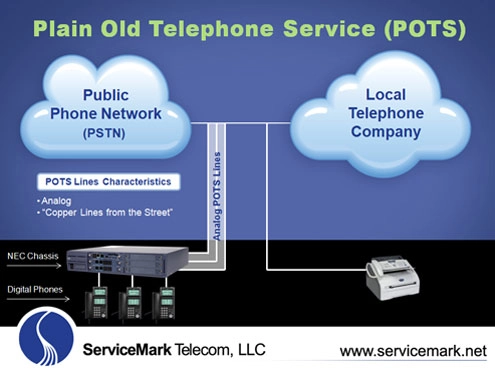
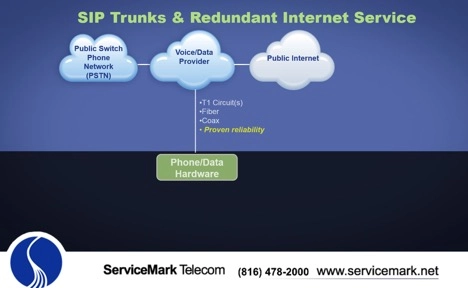
Although Plain Old Telephone Service sounds old fashion and unexciting, it worked with a high degree of reliability! There was a time that phone service was a lot more reliable than it is today. Old reliable POTS lines may still be the best fit for a small business with one location that is only concerned with one main phone number. And a POTS line is still the most reliable connection for a fax machine.
However, POTS lines have their limitations.
* Plain Old Telephone Service does not support Direct Inward Dialing, or private phone numbers that ring directly to individual office telephones.
* POTS doesn’t support a mobile extension feature which provides office phone functionality through mobile phones.
* POTS doesn’t support quality conference calls of more than two outside parties.
* Old fashioned POTS lines may be more expensive than other types of connections that use VoIP technology such as SIP Trunks that are available today.
What is Voice over Internet Protocol or VoIP? The terminology causes confusion because it’s reasonable to assume that it involves talking over the public internet.
* While VoIP can involve talking over the public internet, VoIP is not limited to talking over the public internet.
* A brief definition of VoIP is talking over a public or private IP data network, and the remainder of this presentation will provide a greater understanding of this definition.
All of us have heard poor call quality such as hearing only bits and pieces of words and dropped phone calls. So why is VoIP technology not always reliable?
* One reason is vendors fail to do their due diligence to address points of failure, such as data switches, routers, and the quality of internet service.
* It’s also important to acknowledge that talking over the public internet is described as “best effort” with no guarantees, because vendors can’t control the number of “hops” (or number of routers) that a call has to go through via the public internet, which can result in latency, jitter, hearing bits and pieces of words, and dropped phone calls.
So, can VoIP Technology be reliable? Simply stated, yes. We hope that the following illustration will help begin a dialogue between you and ServiceMark, on how to deploy VoIP and Internet Service with a high degree of reliability, redundancy, and discuss how Unified Communications and remote workers can be integrated into a communications system in a meaningful way.
Today, businesses have a variety of choices for telephone and internet service. It’s commonplace that the same voice and data provider will provide connectivity to the Public Switched Telephone Network and the Public Internet. Phone and internet service can be delivered over the same physical connection. Common connections include T1 circuits that run over copper wires, a fiber optic cable, or a coax cable. Today, all three of these connections have proven to be reliable. All of these connections can hand-off telephone service to a telephone system as plain old telephone service (or POTS lines), as a Primary Rate Interface (or PRI), or as Session Initiation Protocol Trunks (or SIP Trunks).
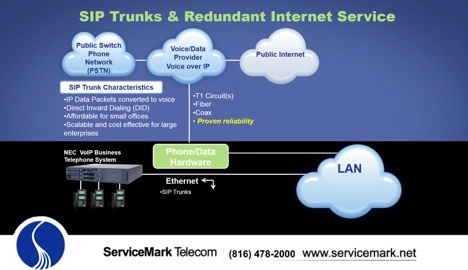
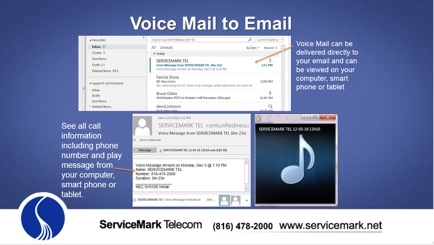
The trend in our industry is SIP Trunks that are cost effective for small offices to large enterprises, so in this diagram we’ve chosen to illustrate a SIP trunk configuration. The voice and data provider is responsible for the quality of telephone and internet service to the customer’s building. Phone and data hardware which is provided by the voice & data provider is connected to the customer’s local area network. The NEC VoIP business telephone system shown in the diagram is connected to the customer’s local area network. This Ethernet connection provides the ability to deploy SIP trunks for telephone service. SIP trunks are IP data packets that are converted to voice. SIP trunks provide Direct Inward Dialing commonly abbreviated as DIDs which provides the ability for every business telephone to have a direct dial telephone number. Today, SIP trunks are affordable for small offices, and are also scalable and cost effective for large enterprises. Using a common connection for voice and data services is made possible through VoIP technology. This example is talking over the voice and data provider’s private data network, and the phone call does not rely on the public internet. In this illustration, the local vendor and voice & data provider can be held responsible for quality and reliability, and this configuration should be very reliable.
It’s also worth noting that SIP trunks can be deployed over the public internet which is a best effort connection, and the quality of connections can’t be guaranteed by the vendor or SIP trunk provider. A more in depth conversation with a ServiceMark representative can help provide a deeper level of understanding to determine if SIP Trunks over the public internet is a good fit for your company.
The Ethernet connection between the NEC business phone system and the local area network also provides for easy system administration by pointing and clicking through a web browser interface. And you don’t have to be an IT person to do this! ServiceMark provides customized system administrator instructions to make it easy for anyone that’s ever clicked a mouse to administer common, everyday changes to the telephone system without having to pay an hourly fee for a ServiceMark Technician.
This connection also provides the ability to deploy computer/telephony applications. For an example, voice mail messages can appear as emails. Users can easily see the name and telephone number in the email subject line. So voice mail messages receive the same attention as emails.
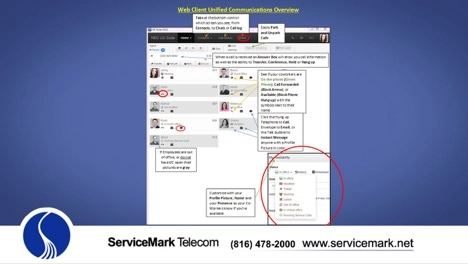
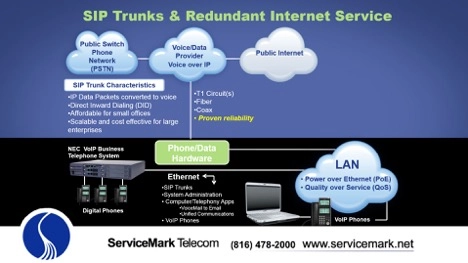
Unified Communications is software that appears on a computer or smart phone that interacts with the NEC business phone system. Unified Communications provides an improved end user experience and provides productive collaboration between workers whether they are working under the same roof, in branch offices, working from home, or mobile workers on the go. Regardless of their location, worker’s feel like they are in one virtual building! Capabilities such as click to dial, drag and drop phone calls, presence, and Instant Message (or chat) for employees working in or out of the office is now commonplace and affordable for businesses of all sizes! Unified Communications is a game changer for businesses in a world that is becoming much more virtual, and there is a real need for more conversation about the impact of Unified Communications to create virtual buildings for remote workers. For step-by-step helpful information on using NEC Unified Communications simply visit the HOW-TO’S & TIPS section of our website, located under the resources menu.
The telephones shown in the diagram below is an illustration of digital phones that connect directly to the NEC Business Telephone System via wires and jacks that are separate from the data network. Since the telephone system connects to the data network, it is possible to deploy VoIP telephones. If data switches are equipped with Power over Ethernet, and Quality of Service to insure quality phone conversations, a single data cable and jack can provide connectivity to a phone and computer.
Digital phones and VoIP phones are both common place, although the trend is to deploy VoIP phones. A more in depth conversation with a ServiceMark representative can help determine which configuration is best and most cost effective for you.
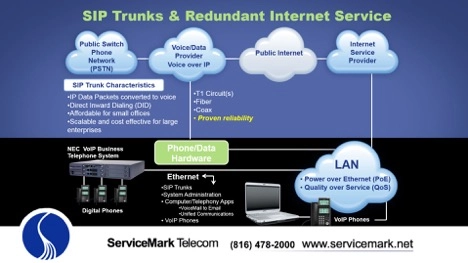
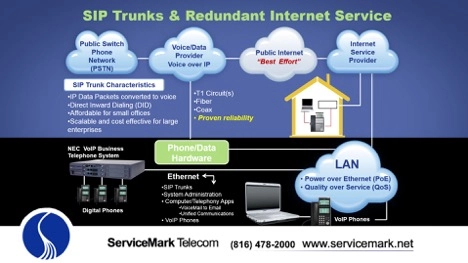
So far in our illustration, we have already created one connection to the public internet. Due to the increased dependence of the internet for daily business operations, it is worthwhile for businesses to consider two separate and redundant internet connections. If the primary internet connection fails, a router with dual Ethernet connections can automatically failover to the backup internet connection.
Because of VoIP technology, it is now possible to have full featured office phone extensions connected off premises using the public internet. These office extensions can be desk phones or software that resides on a user’s computer or smart phone. It’s important to note that the public internet is a best effort connection and the quality of voice conversations is not guaranteed, because vendors like ServiceMark can’t control the number of “hops” (or number of routers) that a call has to go through via the public internet. However ServiceMark can measure the quality of internet service of off-site workers prior to deployment. Today, talking over the public internet has moved beyond experimental and has become a more mature technology, and ServiceMark has several workers that routinely work off site with reliable connectivity of remote VoIP phone extensions.
We hope you have found this presentation helpful. Please feel free to click here to connect to a series of short how to instructional videos for NEC Unified Communications.
For more information, please contact us at 816-478-2000 or support@servicvemark.net.
